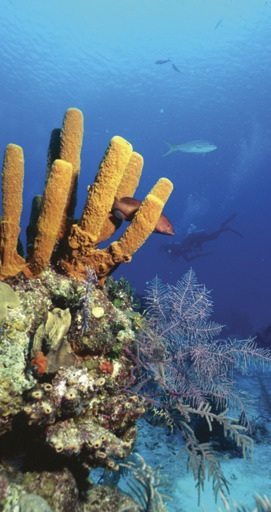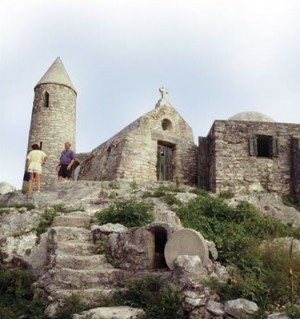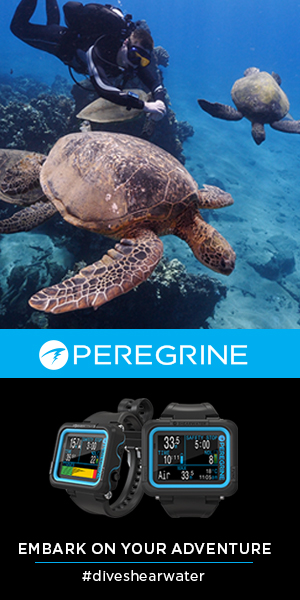If the axiom is true that the more remote the destination, the better the diving, then we’re all in luck: Along the vast chain of Bahamian islands (700 we’re told) there’s plenty of “remote” still waiting to be discovered, and it’s surprisingly easy to find. Simply head “down island” into the southeastern portion of the archipelago. It may take a bit more effort and planning than a trip to the major tourist centers, but adventurous souls will be well rewarded by the islands’ natural beauty.
The Discovery
Historically, the defining moment for the Bahamas Out Islands came in 1492 when Columbus made his first voyage to the Americas. It’s generally accepted that the first landfall was on San Salvador (Holy Savior), where he encountered the native Lucayans.
As his primary mission was the search for gold, Columbus didn’t dally and went on to tiny Rum Cay, tinier Conception Island, then to Long Island. Assuming they were outposts of Asia, Columbus called the islands the West Indies. Both San Salvador and Long Island have impressive monuments at sites where Columbus might have come ashore.
The discovery sealed the fate of the Lucayans, however, who were shipped off the islands en masse to work the mines of Hispaniola (now Haiti), Puerto Rico and Cuba. By 1511, the entire race was decimated. Thereafter, the Bahamian destiny was shaped primarily by its location — that is, right in the path of Spanish ships en route from South America to Spain.
Spanish explorer Ponce de Leon had accompanied Columbus on the second voyage, and discovered a sailor’s dream — the Gulf Stream — which could whip them right along to Florida. With that discovery, North, Central and South Americas witnessed a Spanish invasion, with galleons running shipments of gold for more than a century.
Of course, where there’s treasure, there are pirates, and the Bahamas saw their share of them. In the 1600s Francis Drake and Walter Raleigh simultaneously established colonies for England and preyed upon the Spanish, using the Bahamas as hideouts. Throughout the 17th century, galleons fell to English privateers (the genteel name for pirates) such as Henry Jennings, and later to the infamous likes of Blackbeard, Calico Jack Rackham, Mary Read and Anne Bonney. Nassau became a veritable pirate capital.
In 1718 King George II decided to clean up lawless Nassau and Bahamian waters. He appointed Woodes Rogers as governor of the Bahamas and commissioned him to grant pardons to pirates who agreed to give up their nefarious profession. Those who didn’t comply (including a group from the Exumas) were promptly hung. Ironically, Rogers himself had been a successful privateer literally around the world.
The second defining moment for the Out Islands occurred after the American Revolution, when King George III awarded enormous land grants to the English Loyalists. These were primarily farmers and merchants who remained loyal to England and thus lost their holdings in the American colonies. With American independence, thousands of Loyalists and their slaves settled in the Bahamas, attempting to replicate the plantations they left behind.
The largest number of grants was on Long Island, followed by Exuma and New Providence. Cotton was produced successfully for a short time, but eventually the plantations failed, and only their ruins remain. Emancipation of the slaves came in 1834, and by then many of the Loyalists had already left the islands.
After 325 years of British rule, the Bahamas became an independent nation in 1973. For several centuries, islanders have survived by fishing, sponging, salvaging and farming; in fact, those are still the primary industries in most of the Out Islands to this day.
Getting There
Tourism, although welcomed, has grown very little since the advent of regular airline service. It is possible to fly with a few small charter companies directly between Florida and the Out Islands, but airlines with regular schedules, such as Bahamas Air, use Nassau as a hub. Therefore, travelers must fly into Nassau, and then catch another flight to the Out Islands. Frequently an overnight in Nassau is required, since the last flight out is about midafternoon (none of the runways have lights). Alas, there is no air or sea transportation between islands.
The Topography
Venturing south from Nassau, the sight of one little island or cay (pronounced key) after another, surrounded by white sandy beach, fringing reef and waters ranging from bottle green to midnight blue, is absolutely magnificent. It’s the white sandy bottom and the variation in depth that creates such brilliant pallets.
With a few exceptions, the islands of the Bahamas are surrounded by miles of shallow banks; that is, layers upon layers of limestone deposited over millions of years. During the ice ages water levels would have dropped so dramatically that if populations existed at that time, they would have been able to walk from one island to another.
It was during these times that blue holes were formed and, conversely, when water levels were actually higher than they are currently (scientists estimate at least 13 feet [4 m] higher), the caves that we see above water were carved from their limestone base. Therefore any expedition to the Out Islands should certainly include a blue hole dive as well as a dry cave experience.
At the edge of the banks and into the great trenches and passages, dramatic walls plummet hundreds or even thousands of feet, providing a type of dive experience different from the caves and blue holes. But blue holes and vertical walls are the extremes of Bahamas diving, and many wonderful sites lie at depths ranging from 25 to 65 feet (7.5 to 20 m).
In the eastern portion of the Great Bahama Bank we find The Exumas, Cat Island and Long Island. Their shallow banks and miles upon miles of mangroves are the nurseries that constantly replenish marine life. Off their banks, into deep Atlantic waters and along precipitous walls we find the behemoths of the marine world — huge elephant ear sponges, ledges of mountainous star corals, massive canyon-type promontories — and pelagic species that are a constant surprise as they appear mysteriously from the deep blue denizens.
San Salvador and Conception Island are exceptions to this pattern, as they are actually the tips of undersea pinnacles. As such, they lack a shallow bank and the ocean drop-off is within shouting distance — a perfect diving scenario.
You’ll find that dive operations and lodgings here are small and personalized. Lodgings range from midsized resorts to intimate two-room units. Renting a house is another option that can be a lot of fun for a small group. Dive boats rarely carry more than six divers, and live-aboard vessels are also small, with great diving flexibility and exceptional service.
Following the Exuma Cays
Flying out of Nassau, it takes just a few minutes to reach the northern end of the Exuma archipelago, the long stretch of islands and cays extending for more than 100 breathtakingly gorgeous miles (160 km).
Sailors, particularly, love the area, its protected coves with white sandy beaches and excellent snorkeling. Many anchor at Warderick Wells, headquarters for the Exuma Cays Land and Sea Park, and donate their time clearing hiking trails and doing general maintenance. Divers usually experience the area from live-aboard vessels, which have moorings at the best dive sites.
The Land and Sea Park (started in 1958) stretches for 22 miles (35 km) at the northern end of the chain, from Wax Cay Cut to Conch Cut in the south. In 1986 it became a no-take zone and now serves as an important nursery for fisheries replenishment. Enforcement here is strict, and Bahamian fishermen readily comply, recognizing the benefits. Research (through marine life tagging) has shown that grouper from the park have been found 150 miles (240 km) away on Long Island, and that crawfish (spiny lobster) have repopulated areas around Cat Island, 70 miles (112 km) away.
 Divers will find massive coral heads with sandy channels and winding swim-throughs. Drift dives are made through the channels. Layers of scrolled sheet corals line the narrow passages teeming with schooling silversides and black jacks. At depths ranging from 45 to 70 feet (14 to 21 m), the swim-throughs can send you right over the eastern wall at around 100 feet (30 m). Eagle rays and Atlantic spadefish are common cruisers. Horse-eye jacks school over garden eels that jump out of their sandy burrows. Fat grouper just keep getting fatter.
Divers will find massive coral heads with sandy channels and winding swim-throughs. Drift dives are made through the channels. Layers of scrolled sheet corals line the narrow passages teeming with schooling silversides and black jacks. At depths ranging from 45 to 70 feet (14 to 21 m), the swim-throughs can send you right over the eastern wall at around 100 feet (30 m). Eagle rays and Atlantic spadefish are common cruisers. Horse-eye jacks school over garden eels that jump out of their sandy burrows. Fat grouper just keep getting fatter.
Shark dives are popular here, and there are plenty of sharks to attend the party. As the bait “chumsicle” comes down, they feed like crazy, with cagey grouper waiting patiently for the spoils. It’s pretty exciting, and a great way to snap close-up shark shots. The sharks are ever-present, however, even without a meal, so in these areas every dive is essentially a shark dive.
A fun diversion in the park is an excursion to either Allen’s Cay or Leaf Cay to visit endangered rock iguanas. Curly tailed lizards might show up as well.
The Exumas’ primary population center is Georgetown, Great Exuma, in the southern part of the chain. It’s a popular place for sailors and site of the annual regatta. A single dive business operates near the Peace and Plenty hotel and specializes in blue hole diving near Stocking Island. An 18-hole golf course is located at the Four Seasons Resort at Emerald Bay.
Dropping Into Cat Island Canyons
Across the Exuma Sound, Cat Island curves up like a cat’s tail, and at that curve is a deep underwater canyon replete with sharks and pelagic visitors. The south end wall drops abruptly from about 60 feet (18 m), with layers of plate corals stair-stepping down the plummeting face. Huge channels cut into the wall, and vague images of ever-present sharks weave in and out among enormous coral escarpments. This is truly exciting diving.
Shallow sites, however, are equally exciting, with a prolific amount of plate and staghorn corals, as well as soft corals. Reef fish are plentiful, and at 40 feet (12 m) photographers have plenty of time for photo ops. Snorkelers would enjoy Fernandez Bay, where a lovely resort can arrange for your diving and fishing.
The island itself is sparsely populated, with miles of rolling limestone hills covered with lush vegetation. New Bight Airport is close to the dive centers in the south, and has regular service from Nassau four days a week. Otherwise, private charters can be arranged, with direct flights from Fort Lauderdale, Florida.
 One single attraction here is itself worth a trip to Cat Island, even if you don’t dive. It is the Hermitage on Mount Alvernia, at the highest point in the Bahamas (206 feet [62 m]). Father Jerome, a Franciscan hermit who trained as an architect, built the medieval-style structure out of native stone, all by hand. Walking up the hill, passing by the Stations of the Cross, the Hermitage is not only an impressive structure, but a powerfully spiritual place.
One single attraction here is itself worth a trip to Cat Island, even if you don’t dive. It is the Hermitage on Mount Alvernia, at the highest point in the Bahamas (206 feet [62 m]). Father Jerome, a Franciscan hermit who trained as an architect, built the medieval-style structure out of native stone, all by hand. Walking up the hill, passing by the Stations of the Cross, the Hermitage is not only an impressive structure, but a powerfully spiritual place.
Tropic of Cancer Leads to Long Island
Driving along Long Island’s Queen’s Highway (all 60 miles [96 km] of it), people still wave to one another out of courtesy, and good friends will flash their lights or toot their horns. This certainly is the friendliest of all the Out Islands, and one reason why they were once called the Family Islands. Visitors are not only appreciated, they’re treated like family.
Long Island’s population is only about 3,000, so settlements are small and businesses modest. It is so narrow that many hillside residents can watch the sun come up behind crashing surf on the east side, then watch it drop down below fishing boats on the calm west side.
Although generally rough, the east side has some gorgeous protected coves, perfect for swimming and snorkeling, as well as the amazing 660-foot-deep (200 m) Deans’ Blue Hole (in the settlement of Deans, in the south). The blue hole has become a training site for freedivers, as it is not only deep but extremely accessible.
Tourism matters here, but it’s not nearly as important as crawfish season or baseball season (which follows crawfish season), or the annual sailing regatta. Long Islanders get excited when the mail boat comes in, or they find that Hillside grocery has fresh asparagus.
Diving options off Long Island include shark dives, reef trips, and a visit to the wreck of the Comerbach. Also available are day trips to another no-take national park at Conception Island, to the northeast, with dramatic wall dives that start at 60 feet (18 m) and drop several hundred. Large coral heads near the edge of the wall make spectacular second dives. Day trips are also available to the Nuevitas Wall, which plunges to depths exceeding 2,000 feet (606 m). Along the wall are caverns and swim-throughs, enormous elephant ear and basket sponges and billowy black corals. Monstrous promontories and shelves extend far into the misty void.
About a half mile off the wall at 65 feet (20 m) a grouping of pinnacles come up to within 15 feet (5 m) of the surface. Tunnels snake through the pinnacles at varying depths, good hideouts for huge grouper, parrotfish and snapper.
At the northern tip of the island, visitors should check out the Columbus Monument, then visit Cape Santa Maria Beach Resort, with a gorgeous crescent-shaped beach. In the south of the island, in Clarencetown, shop for crafts and visit Father Jerome’s two imposing churches.
Fortunately, the Bahamas has many more remote destinations, but just too few dive operations to make them accessible. We can hope “soon come,” as the Bahamians say.





